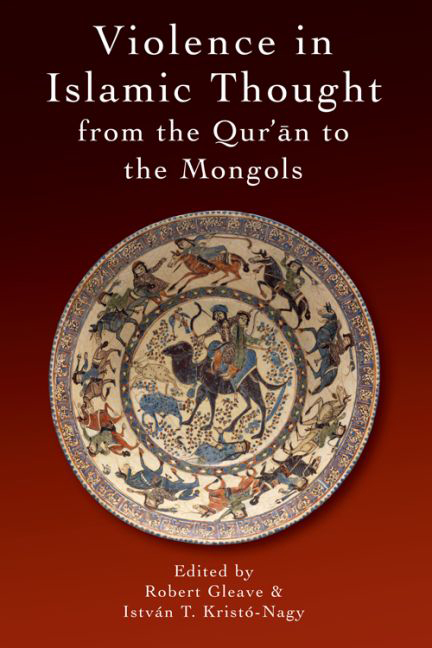Book contents
- Frontmatter
- Contents
- Dates and Abbreviations
- List of Figures and Tables
- 1 INTRODUCTION
- PART I JIHĀD AND CONQUEST: ATTITUDES TO VIOLENCE AGAINST THE EXTERNAL ENEMIES OF THE MUSLIM COMMUNITY
- PART II THE CHALLENGED ESTABLISHMENT: ATTITUDES TO VIOLENCE AGAINST THE STATE AND IN ITS DEFENCE WITHIN THE MUSLIM COMMUNITY
- 6 WHO INSTIGATED VIOLENCE: A REBELLING DEVIL OR A VENGEFUL GOD?
- 7 ATTITUDES TO THE USE OF FIRE IN EXECUTIONS IN LATE ANTIQUITY AND EARLY ISLAM: THE BURNING OF HERETICS AND REBELS IN LATE UMAYYAD IRAQ
- 8 ABBĀSID STATE VIOLENCE AND THE EXECUTION OF IBN ĀISHA
- 9 THE SULTAN AND THE DEFIANT PRINCE IN HUNTING COMPETITION: QUESTIONS OF LEGITIMACY IN HUNTING EPISODES OF ṬABARISTĀN
- PART III LUST AND FLESH: ATTITUDES TO VIOLENCE AGAINST THE DEFENCELESS, INTRA-COMMUNITARIAN VIOLENCE BY NON-STATE ACTORS
- Bibliography
- Index of Qurānic Citations
- General Index
7 - ATTITUDES TO THE USE OF FIRE IN EXECUTIONS IN LATE ANTIQUITY AND EARLY ISLAM: THE BURNING OF HERETICS AND REBELS IN LATE UMAYYAD IRAQ
from PART II - THE CHALLENGED ESTABLISHMENT: ATTITUDES TO VIOLENCE AGAINST THE STATE AND IN ITS DEFENCE WITHIN THE MUSLIM COMMUNITY
Published online by Cambridge University Press: 15 September 2017
- Frontmatter
- Contents
- Dates and Abbreviations
- List of Figures and Tables
- 1 INTRODUCTION
- PART I JIHĀD AND CONQUEST: ATTITUDES TO VIOLENCE AGAINST THE EXTERNAL ENEMIES OF THE MUSLIM COMMUNITY
- PART II THE CHALLENGED ESTABLISHMENT: ATTITUDES TO VIOLENCE AGAINST THE STATE AND IN ITS DEFENCE WITHIN THE MUSLIM COMMUNITY
- 6 WHO INSTIGATED VIOLENCE: A REBELLING DEVIL OR A VENGEFUL GOD?
- 7 ATTITUDES TO THE USE OF FIRE IN EXECUTIONS IN LATE ANTIQUITY AND EARLY ISLAM: THE BURNING OF HERETICS AND REBELS IN LATE UMAYYAD IRAQ
- 8 ABBĀSID STATE VIOLENCE AND THE EXECUTION OF IBN ĀISHA
- 9 THE SULTAN AND THE DEFIANT PRINCE IN HUNTING COMPETITION: QUESTIONS OF LEGITIMACY IN HUNTING EPISODES OF ṬABARISTĀN
- PART III LUST AND FLESH: ATTITUDES TO VIOLENCE AGAINST THE DEFENCELESS, INTRA-COMMUNITARIAN VIOLENCE BY NON-STATE ACTORS
- Bibliography
- Index of Qurānic Citations
- General Index
Summary
INTRODUCTION
Capital punishment can be understood as simultaneously an exercise of actual power – the ending of a human life – and an exertion of symbolic, or ritual, power. In this combination of symbolic transformation with real physical change, executions are unusual rituals. But the use of extreme violence against the human body certainly does have ritual characteristics, in that it has established rules (which may, of course, be deliberately challenged or broken) and in that these rules are used to make the drastic transformation in the status of the executed party seem legitimate and proper, to reassert more general ideas about the correct social order and to communicate threats and warnings to others who might seek to upset it. The victim of the execution is quite literally marked out as beyond reintegration into society. Their body becomes a kind of text, which can be read in a multitude of ways: the authorities carrying out the killing usually have one set of messages in mind, but the victim themselves, and those who witness or remember the act, may have very different ideas.
This ritual character of public executions poses interpretive problems. Philippe Buc has reminded medievalists that accounts of all rituals in narrative sources present particular challenges because of the polemical purposes to which they are put. This problem is acute for the Umayyad period of Islamic history (661–750 CE). Documentary sources for many aspects of Umayyad political culture, including capital punishment, are scarce. Furthermore, the literary accounts of events were composed after the Abbāsid Revolution, which brought the Abbāsid dynasty (r. 750–1258) to power in a violent rebellion against Umayyad rule. The Abbāsid period then witnessed the ongoing evolution of Islamic religious thought and practice, including the formation of some of the main features of classical Islam. Hence, the sources may manifest religious, legal and political ideas quite different from those that prevailed in Umayyad times.
Four unusual episodes from the end of the Umayyad period suggest that, although Buc's warning is well founded, sensitivity to the concerns of the sources means that they gain in their potential as sources.
- Type
- Chapter
- Information
- Violence in Islamic Thought from the Qur'an to the Mongols , pp. 106 - 127Publisher: Edinburgh University PressPrint publication year: 2015



